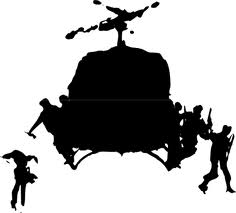

Despite the Sundering, prosaic authorities get wind of bizarre events from time to time, from their intelligence agencies. Major governments often establish secret groups to monitor and cope with these events, border guards, as it were, along the Sundering. Examples:
There have always been sunder guards, formally organized or not. The vizier Yahya Ibn Khalid kept djinn from messing up Haroun al-Rashid, and members of the Fourth Philosophy (the Zealots) realized that vampires shouldn't be telling King Herod what to do, no matter how much of a bastard he was. Many a king or emperor has had court magicians scrying and spelling for his magical safety.
Since the Enlightenment, there's a new side to sunder guards, and a new risk. They are also research organizations now, since, after all, many of the things they deal with "should not" exist, and anomalies are very interesting, in an offensive sort of way, to the scientific method. That's the new side. The new risk is that research means more involvement with esoteric people and events, which raises the risk of becoming Sundered yourself. Sunder guards lose a lot of researchers to mysterious disappearance, or to "obvious insanity," causing the researcher to be gently put out to pasture, after which they often disappear anyway, much to their employers' annoyance and aggitation.
Sunder guards might sound like Orders all over again, but they are not. They have no angelic backing; they are a purely human thing. Teetering on the edge of the Sundering as they do, they are much less knowledgable. And their goals are purely secular.
For example, Greenwood has not always seen eye-to-eye with Logres. They were first aware of Logres as an idealistic band of monster- and witch-hunters claiming descent from King Arthur's Round Table. They were helping British imperial ambitions, so that was fine with Greenwood; they largely left Logres alone. Then the Great War came and most of Logres was wiped out. A pity, but no more, from Greenwood's point of view; they had no notion the Order was being purged of its jingoism.
Between the World Wars, Logres turned penitent and, led by Col. Michael Fisher-King, began working to undo and prevent the evil aspects of British imperialism, largely in India. This did not suit Greenwood at all, and the two groups, when they encountered each other, were often antagonistic.
After WWII, with Fisher-King dead, Logres seemed reduced to an invalid philologist and his friends. Greenwood made no connection, at the time, between Logres and the N.I.C.E., then a darling of the government and not in the least esoteric so far as Greenwood knew. Of course, when the N.I.C.E. was blown away in a mysterious catastrophe shortly after moving its headquarters to the same area where Logres had its seat, Greenwood noticed, but then it was too late. Besides, things began to come out about the N.I.C.E, and, retroactively, it had never been the government's darling. Greenwood and Logres had a complex relationship, sometimes cooperating, sometimes at odds, during the cleanup and investigations that followed; Logres wanted to destroy various documents and artifacts Greenwood wanted to acquire and study.
Since then, the two groups have been generally annoyed with each other. Logres is always trying to destroy specimens that Greenwood wants to study, and making alliances with nationalistic esoteric groups (other Orders) all over the globe without regard to British policy. But the two rarely encounter each other. Both are spread very thin. Also, Logres mainly goes after esoteric things they think are spiritual dangers to British culture (or they are sent after their targets through the manipulation of circumstance by the British Principality, an angel some modern Logreans have nicknamed "Atkins"). Meanwhile, Greenwood mostly goes after esoteric things they think are dangers to national security. The two sets of targets don't necessarily overlap. When they do, the two are often forced by circumstance to cooperate. (And remember who makes a speciality of manipulating circumstances in esoteric Britain.)

Founded in Nottingham shortly after the Norman invasion, Greenwood was revived in Scotland, in 1879, by Queen Victoria, after she was attacked by a werewolf. They take the name from Luke 23:31 – "If they do these things in the green wood, what will they do in the dry?" – which Victoria took to mean that, if even someone as well-protected as a queen is open to supernatural attack, what about everyone else? The internal meaning is that there are worse times coming and they should prepare.
From its start, Greenwood has had a general animosity toward the esoteric; supernatural / magic / psychic / paranormal = enemy. They are very much the Crown's monster-hunters.
Since some of the monsters are intelligent, Greenwood is ruthless about staying secret. The only reason they let Stoker publish the letters and diary entries of the humans involved when Prince Vlad Tsepes Dracula tried to invade England shortly after Greenwood's revival is that they saw that presenting the incident as fiction was the best way to hide it. And you've never heard of the Edinburgh Werewolf, the Pevensie Anomaly (except in the most heavily disguised form), the Barsetshire Regulars, the Devonshire Vampires, what's buried under Amesditch, or what really became of Spring-Heeled Jack.
Their contacts in the mundane government are limited to the Prime Minister, the monarch, and whoever the monarch deigns to tell. (Greenwood almost always wishes the royal lips would stay a bit better buttoned, but after all it's a hell of a secret and you have to talk about these reports with someone. So the consort and one or two very close friends usually get let in. The heir is generally left to find out for themselves).
Greenwood is very possessive of weird stuff: "If it's magic, it's ours." They want specimens to investigate and weapons to use. Any British magician that poses any problem at all will be taken down and looted. Non-human problems are generally killed, but, if they leave a body, it's taken in for examination. Greenwood has quite a collection of bottled ghosts; they disapprove of ghosts more than they disapprove of ghost-drinking and so take no steps against the ghost trade. Their research facilities are in their safe-houses, scattered in isolated bits of British countryside.
Since they have to pick up their talent where they can, Greenwood has been progressive about using agents of any class, religion, race, or sex. It is currently headed by Capt. Jacob Harker, of Jamaican extraction, who took the post in 1978 and still looks a vigorous fifty—presumably the result of some of that magical looting. He and his staff have a reputation (in a very small circle) for showing up abruptly, acting abrupt, and leaving abruptly, but when they leave at least things are back to normal. They keep close tabs on each other, since Greenwood agents who have "gone under deep cover" have often not appeared again, or not as Greenwood agents.

The Department of the Ulterior was established by Thomas Jefferson during his presidency. Although a lifelong rationalist and deist, Jefferson also recognized the existence of the paranormal; he was never entirely satisfied with the outcome of the debunking of Anton Mesmer that Benjamin Franklin participated in, and he had had encounters with Amerind ghosts and Norembegans (North American elves) during and after his archeological excavation of an Indian mound. These spurred him to investigate such phenomena as Indian medicine men, voodoo witches among the slaves, the Tillinghast vampires in New England, and other American paranormalities. He did not see a great deal of weirdness himself, but he still felt it worth while to set up this secret department and appoint a Secretary of the Ulterior to run it. He also sent an Ulterior operative on the Lewis and Clark expedition, though nothing resulted except some notes of an anthropological character.
The modern Ulterior department is staffed by the Secretary and a small number of agents. The agents are salted among other intelligence agencies as ordinary agents in slightly anomalous corners of the bureaucracy. The Secretary him- or herself (the first female Ulterior Secretary was Madeline Littlejohn, appointed by Calvin Coolidge in 1924) reports to the president only at need. Whole administrations have gone by without the president even learning of the existence of this part of his own cabinet. The Secretary is replaced only on retirement, and usually recommends a successor to the president, who usually accedes.
The Department of the Ulterior is charged with defending the federal government against paranormal dangers – dangers no other security agency would believe in. They monitor paranormal activity as well as they can, liaison with the esoteric groups that they know about and consider benign, and, most importantly but most rarely, act as monster-hunters and ghost-busters where the operation of the federal government is concerned. (One of the few permanent posts in the Department, besides Secretary, is the Lincoln Liaison, held by a Secret Service mole on regular duty in the White House. Their Ulterior duty is to be "available" to the sixteenth president as necessary.)
The Department of the Ulterior has tagged the Dare Lodge as "generally benign" and ignores them, for the most part. Both are enemies of the Knights of Palmito Hill, Ophel, and Marie's Horses, but the Ulterior regards the Lodge as foolishly amateurish, and seldom helps them, though they are happy to follow up on tips. Often, the two simply don't overlap: The Dare Lodge doesn't care about cattle mutilations and the apparent "black helicopters" (or what look like black helicopters after they hatch out of the cattle), because they're not evil. The Ulterior doesn't care much about the ghost trade, within limits, and doesn't quite believe the Tech Barons are a real threat anyway.
If the Dare Lodge wishes the Department of the Ulterior would be more helpful, the Grandmother Spider Society often wishes they would simply butt out and leave the experts to handle relations with animal spirits, Norembegans, and Puckwudgies. The Ulterior has sometimes been helpful on windigo hunts and catching skinwalkers, but more often the two just get in each other's way.
The current Secretary is Laurel Heller, a Carter appointee. She and her small troop of agents are an angsty bunch.

The Eclipse Directorate was founded, under the name la Garde d'Éclipse, during the Reign of Terror, to defend against the plague of wrathful ghosts released by the mass executions. The Kerdeans believe that many techniques of the ghost trade were developed or became much more widely disseminated under la Garde d'Éclipse. La Garde continued under the Directory government, renamed le Directoire d'Éclipse, controlled by the Eclipse Director.
The Eclipse Directorate was disbanded at the end of the Republic, but reinstituted by Napoleon. It went underground or rogue when Napoleon was exiled, but continues to function to this day, recruiting from French espionage networks. As with the Department of the Ulterior, it is a department most French presidents don't even know they have. The current Director is Emil Lonvelin.
Very shortly after its inception, the Eclipse Directorate found itself up agains l'Armée du Soleil, the French Cabal, which would have put a Bourbon on the throne of France if the Directorate and les Chevaliers de Charlemagne had not jointly opposed them. In this way, the Directorate learned of the existence of the Chevaliers, whom it regards as an organization similar to itself, a precursor dating back to the early Middle Ages (which explains their religious overtones). Since that time, the Directorate and the Chevaliers have been distant allies against l'Armée. The Directorate thinks somewhat more highly of the Chevaliers than Greenwood does of Logres.
During World War II, the Directorate fought der Ahnenerbe in an occult spy-war. It joined forces with the Chevaliers, and Geroldseck, the Teutonic Order, in hunting down and wiping out the last remnants of der Ahnenerbe at the end of the war. Since then, aside from "routine" ghost-busting and occasional werewolf- and vampire-hunts, the Directorate's main job has been thwarting the activities of the CPPU in France.

The Committee for Dialectical Extrapolation derives from the CPPU (Committee for Psycho-Physical Unity). The CPPU started out as the USSR's sunder-guard and almost immediately became its Cabal as well. It was founded in 1920, in response to an attempt on the life of Joseph Stalin by Polish necromancers allied with patriotic Polish ghosts. At first, it presented itself on the model of the British Psychical Research Society, with the mandate of making the world philosophically safe for dialectical materialism, but with true goals more along the lines of ghost-busting, making Joseph Stalin safe from supernatural attack.
Ghost-busting soon brought the CPPU into conflict with the Court of the Tsar-Patriarch, the pre-Soviet Cabal of Russia, now abandonned by Hell but unaware of that and still active. The CPPU's first and greatest triumph was the destruction of the Court in 1942, killing the last Tsar-Patriarch and looting his greatest treasure, the Stepmother, a powerful infernal djinnia from the djinnish kingdom of Ararat, captured or enlisted by the Court (it is unknown which) in 1883.
The Stepmother served the CPPU just as willingly as she had the Tsar-Patriarch, either because of the terms of a geas on her or simply on orders from the Russian Tyranny. But setting up the Stepmother in the USSR and extending her reach to Soviet satellites meant that the CPPU had to deal with agents from many other Soviet agencies, who became formally or de facto CPPU members. Cliques and frictions developed.
The higher levels of the Soviet government wanted more spectacular successes like the first one. The old hands of the CPPU and their disciples saw to it that the mere "genie-handlers" were separated off into the Committee for Dialectical Extrapolation (a deliberately obscure name) in 1943, while they went off trying to develop gestalt telepathy, clairvoyant espionage, psi weaponry, etc. The CDE retaliated by making sure they were elevated to a peer rank with the CPPU and that they were the ones plugged into the espionage network – easy, since most of them were spies from other networks to begin with. This effectively created a theory/practice separation which basically pleased both halves of the divsion. However, the CDE's efforts to shoulder the CPPU out of the espionage networks failed, thanks to the CPPU's infernal backing, including the collusion of the Stepmother.
Through serving and protecting the Stepmother, the CDE became the Soviet sunder-guard – it did the functions of a sunder-guard, using the Stepmother as their trump card against lesser supernatural annoyances, and the Tyranny did not use it for the cultural-steering projects that it used the CPPU for. It remains true that the Russian sunder-guard and Cabal are unusually close, though often rivalrous.
With the Stepmother's death in 1988, the CDE had to work hard to justify its continued existence. But it could point to all the monster-hunting, monster-recruiting, and ghost-busting it had done since its founding, done without recourse to the Stepmother.
The CPPU survived more easily, having distanced itself from the CDE and the Stepmother, but when the USSR fell in 1991, it deliberately "disbanded" itself so as to go underground. The CDE knows of its continued "rogue" existence, though, and so do may other espionage agencies, both Russian and foreign. The CDE also lost all official existence, but is now a secret society, continuing to act as Russian sunder-guard with tacit government permission. It uses a think-tank, the "Institute of Pan-Slavic Cultural Psychometrics," as its front. It is still rabidly, jingoistically patriotic, but not quite as viscious as formerly, thanks to the growing distance between it and the infernal CPPU.

WIT is the sunder-guard for the United Nations and thus presumably for the whole world. Well, they try. WIT was founded in 1948, in Israel, during the Palestine War, when a British commander of UN troops found himself up against Arabs commanding djinnish forces. He received surprising kinds of help from an American diplomat. The diplomat turned out to belong to the Department of the Ulterior. The British commander turned out to belong to Greenwood, and was able to bring in an agent of the Eclipse Directorate working in Beirut when the two of them needed still more help. (No one suspected any involvement by the Eidah Yaakov, one of the two Jewish Orders, or even suspected the existence of the Order.)
Ever since then, the British, American, and French sunder-guards have always lent support to WIT, and the membership has slowly broadened to include sunder-guards of other nations and even esoteric organizations of other types – sometimes including Cabals and Orders. The Kerdeans have been openly associated since 1953. Other associated groups include the Men of Sherwood, the Knights of Solomon, and the Teslaniks. The sunder-guards of Russia, China, or any Arab nations other than Saudi Arabia and Lebannon have been excluded, causing much ill feeling.
WIT exists within the UN's organization without the UN's knowledge, maintaining its precarious position with some esoteric skills of its own (the blank white cards that always appear to be the right ID, no matter the circumstances, for instance). It lends its strength to any sunder-guard that appears to need it – often without being asked, which occasions some annoyance. It has sometimes tried to intercede when opposed sunder-guards fight each other, but the result have always been very messy.
The current commander of WIT is Brigadier General William Warfield-Gordon, working with a few dozen special-operations soldiers with esoteric training, and with various UN diplomats who are members of their nations' sunder-guards.
Return to Inkliverse
Return to Wind Off the Hilltop
Copyright © Earl Wajenberg, 2010